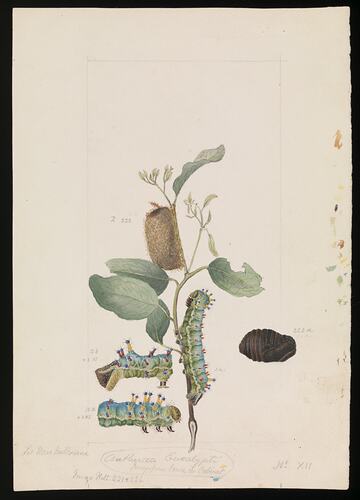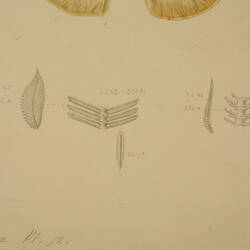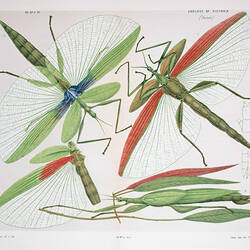Summary
Unpublished watercolour, pencil & ink illustrations by Arthur Bartholomew of the larvae (D12) and pupae (D222) of the Emperor Gum-Moth, Opodiphthera eucalypti (originally identified as Antheraea eucalypti), and their host plant. The caterpillars were collected from near Melbourne, and were grown in captivity until the moths emerged - see PZD 221 and PZD 226.
Frederick McCoy, the first Director of The National Museum of Victoria, presumably commissioned this work for a future plate in 'The Prodromus of the Zoology of Victoria; Figures and descriptions of the living species of all classes of the Victoria indigenous animals'.
For more than 40 years, McCoy brought specimens to Bartholomew who observed and nurtured them specifically to illustrate them for the Prodromus. Bartholomew was methodical and the quality of illustrations was both consistent and accurate. In this illustration his method is clearly revealed. Having noticed a larva which had spun itself into a cocoon, or the emergence of a perfect moth from its chrysalis, he would then carry the specimen to his drafting table and set to capture its exact likeness and colour. Examining his subject under a magnifying glass, Bartholomew would first describe the form with fine pencil lines, before building up overlapping washes of watercolour and eventually adding glazes of varnish and gum Arabic. At last he would capture the colour saturation and level of sheen in each part of the specimen, achieving a subtle three-dimensionality reproducing both likeness and texture.
Publications such as the Prodromus reached a peak in popularity with the work of John Gould in England and the earlier work of James Audobon in America. In Australia, many professional and amateur publications, including Aldine's systematic studies of the colonies and Louise Anne Meredith's Bush Friends From Tasmania, contributed to the genre.The publication of the Prodromus was an enormous undertaking, utilising the work of numerous artists, collectors, lithographers and publishers, over an extended period of time. McCoy died without completing his systematic study, but even at the time few believed that 'any of us will live to witness the completion of the work, if the entire Fauna of Victoria is to be illustrated.' Although costly in both financial and professional terms, the Prodromus was met with critical acclaim and wide popular support. Financial battles were waged and lost by McCoy, but ultimately the Prodromus has stood the test of time and remains one of Museum Victoria's finest publications.
Bartholomew's illustration forms part of the much larger Prodromus Collection. Many of the original illustrations and prints in the collection informed the production of The Prodromus, the first major publication of the National Museum of Victoria. Between 1878 and 1890, McCoy published his zoology 'Prodromus' as 20 parts in two volumes, with each part comprising 20 plates. Unfortunately, almost 90 plates in the collection remain unpublished, and hundreds of illustrations were either not completed or not printed.
Description of Content
Emperor Gum-moth, Opodiphthera eucalypti, by Arthur Bartholomew. Illustration - pencil, watercolour, ink and varnish on paper, 27 cm x 25 cm. Drawing number 12, commissioned by Frederick McCoy as part of his zoological research.
More Information
-
Collection Names
-
Collecting Areas
-
Artist
-
Medium
Watercolour and Pencil
-
Technique
Scientific illustration
-
Support
Paper
-
Drawing Number
12 & 222
-
State
Illustration
-
Primary Inscriptions
No.XII / Anthyraea Eucalypti / Loc. Near Melbourne / image from larvae in Cabinet
-
Secondary Inscriptions
D12, / 12a +2 ns / 12b +2 ns / D222 / 222a
-
Tertiary Inscriptions
Imago plate 221 & 226
-
Classification
-
Taxon Name
-
Author and date of publication
(Scott, 1864)
-
Preferred Common name
Emperor Gum-Moth
-
Kingdom
-
Phylum
-
Subphylum
-
Class
-
Order
-
Superfamily
-
Family
-
Subfamily
-
Genus
-
Species Name
eucalypti
-
Category
-
Discipline
-
Type of item
-
Overall Dimensions
17 cm (Width), 25 cm (Height)
-
Dimensions
252 mm (Length), 175 mm (Width)
Measurement From Conservation.



